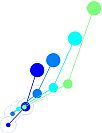The looming pollination crisis calls for a better understanding of pollinator foraging behaviour. Insects, birds, and mammals develop complex foraging patterns, such as multi-destination routes called ‘traplines' that mediate pollen dispersal and, ultimately, plant fitness. However, the prevalence of these behaviours across species and environmental conditions remains poorly understood. Here, we argue that traplining may only be observed in rare conditions. We instead expect diverse movement patterns to emerge from a common set of behavioural rules through the influence of the environment. We support this claim by measuring the diversity of route repetitiveness across pollinators in a systematic literature review. We then use a cognitively realistic agent-based model of bee movements to show how the interplay of cognition, competition, spatial distribution of resources, and nectar replenishment rate, can generate various foraging patterns. We suggest bee movements are more repetitive when resources are scarce and spread in space, when nectar renewal is fast and when competitive pressure is low. Our findings challenge both the assumptions of a large prevalence of traplining in the behavioural literature and of random pollinator movements in pollination models. Predicting plant mating patterns through a more detailed understanding of pollinators' movements will help improve precision agriculture and conservation.
Recherche par auteur > Lihoreau MathieuHow pollinator foraging movements emerge from the interaction between cognition and the environment
1 : Centre de Recherches sur la Cognition Animale - UMR5169 Université Toulouse III - Paul Sabatier, Centre National de la Recherche Scientifique, Centre de Biologie Intégrative, Toulouse Mind & Brain Institut
|

 PDF version
PDF version
